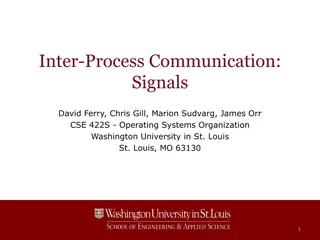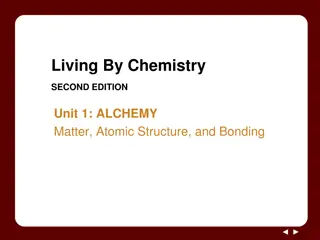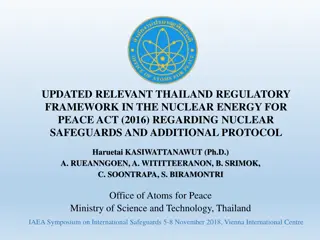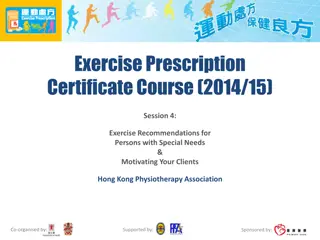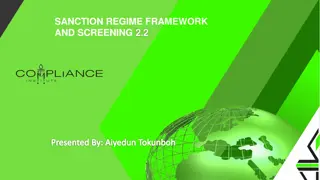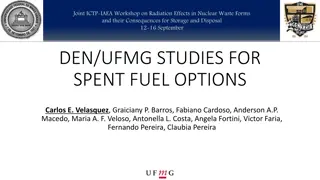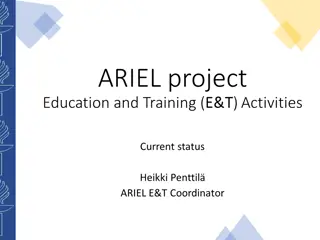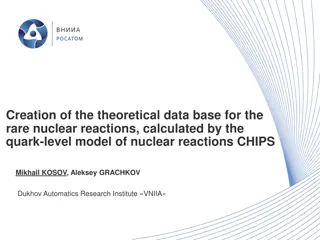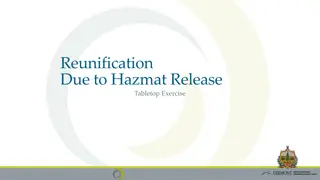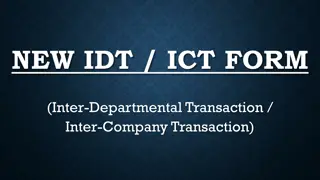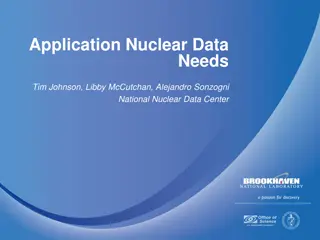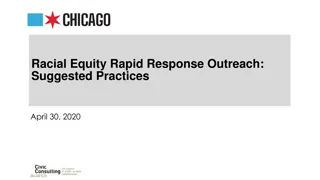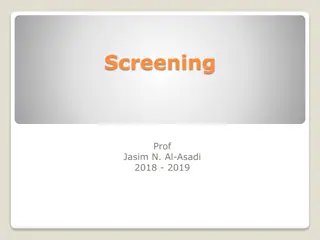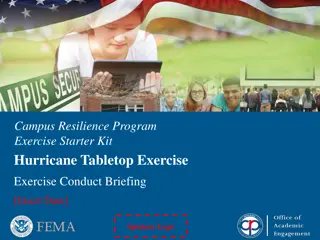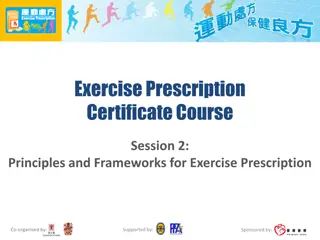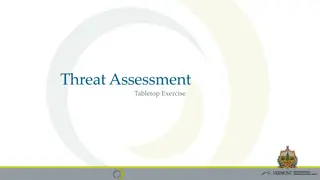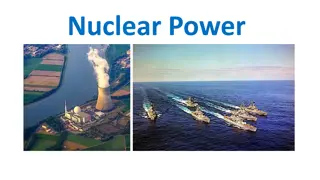Inter-Comparison Exercise on Nuclear Explosion Signal Screening
The 1st Nuclear Explosion Signal Screening Open Inter-Comparison Exercise in 2021 involved participants from various institutions worldwide to evaluate the detection power of anomalous measurements related to nuclear explosions. The exercise included processing a test data set with different scenarios and using atmospheric transport models to analyze the data. Participants submitted results based on various methods to identify anomalies in the dataset. The evaluation focused on detecting anomalies regardless of their cause, mainly using xenon isotopes as indicators. The approach involved calculating residuals, true positive rates, and false positive rates to determine the effectiveness of the detection method.
Download Presentation

Please find below an Image/Link to download the presentation.
The content on the website is provided AS IS for your information and personal use only. It may not be sold, licensed, or shared on other websites without obtaining consent from the author. Download presentation by click this link. If you encounter any issues during the download, it is possible that the publisher has removed the file from their server.
E N D
Presentation Transcript
1st Nuclear Explosion Signal Screening Open Inter-Comparison Exercise 2021 Christian Maurer1, Paul Skomorowski1, Ramesh S. Sarathi2, Alexander Hieden1, Boxue Liu3, Jonathan Bar 3, Jerome Brioude4, Delia Arnold Arias1, Yuichi Kijima3, Brian T. Schrom2, Jennifer M. Mendez2, Anne Tipka3, Jolanta Kusmierczyk-Michulec3, Martin Kalinowski3, and Robin Schoemaker3 1Zentralanstalt fuer Meteorologie und Geodynamik(ZAMG) 2Pacific Northwest National Laboratory (PNNL) 3Comprehensive Nuclear-Test-Ban Treaty Organization/International Data Center(CTBTO/IDC) 4Laboratoiredel'Atmosph reetdes Cyclones (LACy)
1. Test data set structure 48 date-times * 53 grid points * 23 IMS time series = 58512 data files Samples for the whole year 2014 according toactual dataavailability Uniformlydistributedover the globe with denser sampling of latitudes compared tolongitudes Each data file potentiallyimpacted by oneexplosion Fourper month 24 hours containment, 10% release within onehour Immediate release, 0.92%venting 2544 explosion scenarios: Burnett etal.(2019)underwater& IDC undergroundsourceterm: No mixing of explosions. At maximum 14 days are influenced by a hypothetical explosion. Sample meta data included (MDC, LC ect.). The full data set cannot be processed/handled during the 1st Nuclear ExplosionSignal Screening Open Inter-Comparison Exercise 2021 -> reduction to 424scenarios (8 date-times, four target periods for ATM) - not necessarilyexplosions
2. Participants Name Institution Country Confidential emission data (IRE & ANSTO) requested ATM +meteorology combination Level1 results (ATM only) submitted Level2&3 results(screening of test data set with own methods) to besubmitted P. de Meutter, A. Delcloo & C.Gueibe SCKCENRMI Belgium Yes FLEXPART V10.4 + ECMWF Yes Yes S. J. Leadbetter MetOffice UK Yes NAME 8.3 + MetOfficeUnified Model Yes No J.Kusmierczyk-Michulec CTBTO ( XeBet ) Austria - FLEXPART V9 +ECMWF Yes (Xe-133only) No M. Schoeppner IAEA Austria Yes FLEXPART V9 +ECMWF Yes Not likely P. Tayyebi NSTRI, AEOI Iran Yes J. Roberts, J. Lucas USNDC US Yes S. Wang, Q. Li, Y.Zhao BRL China Yes U. A. Kadiri, H. A. Muhammed, I. Dodo CGG Nigeria Yes A. Qu rel, D. Qu lo, O.Saunier IRSN France Yes M. Goodwin, D. Chester AWE UK Yes R.S. Sarathi PNNL US So far 4 participants, international interest
3a. Evaluation: DetectionPower Question: Is a measurement an anomaly (regardless of what has causedit)? Approach based on ATM of civil sources (use of Level 1 results -tricky): 1. Calculateresidualsbetweenthe testdatasetvaluesandaparticipant scivil backgroundestimatesperIMSstationandseparatelyfor all radioxenonisotopes. Filter thetestdatasetaccordingtoLCin ordertopreventaccountingforsamples belowLCthatcouldbesolelydueto the detectorbackground. Claim a detectionif acertainpercentilevalueofall the residualsis exceededfora sample. Calculatethe truepositiveandfalse positiveratesfor anyof thefourxenon isotopes. Optionally:Applya movingaverage[t-1,t+1]tobothtime series beforeresidual calculationto preventrelyingonsingle sample values. 2. 3. 4. 5.
3b. Evaluation: ScreeningPower Question: "Has an underground or underwater nuclear explosion to be assumed based on isotopic ratios? Approach: Based on all claimed (true and false) positives according to detection power evaluation and on multi-isotope detections (2 to 4 isotopes) evaluate true positive and false positive ratesfor: I. Threeand fourxeonon isotopediscriminationrelations(Kalinowskietal.,2010): AC2 u2 ACy u2ACx ACx2 ACx 2 x,testset+ ;u2 R = R2 ; u2 ACx = ERRAC x,modelled Sx ; S : detectorsensitivity R = + x ACy2 ACy Ra,b < Ka,b,c,dRc,dma,b,c,d Comparison to xenon flags for xenon isotope pairs: Xe-133m/Xe-131m > 2, Xe-135/Xe-133 > 5,Xe-133m/Xe- 133 > 0.3 and Xe-133/Xe-131m >1000 a) Bayesian limits (Zaehringer and Kirchner,2008): ?? = ?? + ?(?? )????????(1 0.975????????(?? ?(?? )) ??+ = ?? + ?(?? )????????(1 0.025????????(?? ?(?? )) R x,y x y x,y x y = AC AC+; R+ = AC+AC b) Fieller stheorem(Axelssonetal.,2014): II. ? ? ? ? ? ? ? ? ? ? (?????? ?4????)2 (??2 4?2)(??2 4?2) 1 ? = (?????? ?4????) ??2 4?2 ? ?, ? ? ? ? ?
3c. Evaluation: TimingPower Question: "Can we determine time zero +/- uncertainty within a predefined timewindow? Approach: ? ?133?? ForXe-133andXe-133m:?133?/133? = 1. 1 ?133 1 ? (?133 ?133?)?+ ? ?133? ? ?133?? ?133 ?133? ?133?/1330 If Xe-133m is not present: E.g.,?135/133 ? = ?135/133 0 ? (?135 ?133)? Analogous,simple relationsforXe-133m/Xe-131mandXe-133/Xe-131m(noparent-daughterdecay). 2. ? ?135? 1 ? (?133 ?133?)?+ If Xe-133mispresent: E.g., ? ? = 3. 135/133 1 ?133 1 ? ?133? ? ?133?? ?135/133?0 ?133 ?133? ?135/1330 Analogousrelationfor Xe-133/Xe-131m(Parent-daughterdecayto beconsideredif Xe-133is involved). Evaluatetiming successratesbasedon single samples which wherefoundtobe true positivesafterdetectionand screeningpower evaluationandon a 10%tolerancecriterion. 4. Tolerance (10% of thetotal uncertainty) For the purpose of estimating the uncertainty the release scenarios include one case at hour zero (immediaterelease) and anotherat 24hoursas well asU-235andPu-239fissionmaterials. Uncertainty Xe-135/Xe-133 Xe-133/Xe-131m Xe-133m/Xe-131m Xe-133m/Xe-133 57h 45d 24d 16d 6 h 108h 58h 38h
3d. Evaluation: Location and Magnitude estimation Power Approach: Very limited evaluation 1. Location Power: Calculate the percentage of cases for which there are 1) two, 2) three or 3) more than three detections related to a nuclear explosion regardless of the isotope. (PSR fields can be calculated blending different isotopes as well as detections and non-detections. Minimum is one detection and two non-detections.) 2. Magnitude estimation power: If there are two detections related to a nuclear explosion, location and releases for two isotopes could be estimated. If there are three detections related to a nuclear explosion, location and releases for three isotopes could be estimated. If there are four detections, location and releases for two or up to four isotopes could be estimated (depending on whether there are different two- or three-isotope ratios involved in case two two- or three-isotope ratios are present). Count the number of different detected isotopes for each of the different above settings (i.e., 1) two, 2) three or 3) more than three detections regardless of the isotope). Include only samples in the statistics which where found to be true positives after detection and screening power evaluation.
4a. Detection power based on ATM for civilsources Models tend to produce similar output (-> see ensemble analysis of 3rd ATM Challenge). There is some skill for Xe- 133 andXe-133m. There is hardly/no skill for Xe-131m and Xe-135. But ATM runs (especially source terms) need to bechecked! The optimum residual threshold can be empirically determined, ranging approximately from the 55th to 70th percentile (depending on the isotope and the specific ATMrun). OverpredictingATM run forXe-131m!
4b. Detection power for different datasets Slightly higher overall detection power for Xe-133m than forXe- 133 (-> source term + civil Xe background) Higher detection power for underground compared to underwatertests(->sourceterm) No detection power for Xe-133, but small one for Xe-133m for underwatertests(->sourceterm) Higher detection power for tropics compared to extratropics (-> lower civil Xe background in the tropics?) Considerable differences between seasons (->?) Longer periodwith civil background predictions -> better results Jouden index = Sensitivity (= TPR) + Specificity (= 1-FPR) -1; [-1,1]
4c. Screening & timing power with/without ATM support Use of ATM enhances screening and timing power results to different extents. Largest improvements are seen for 2-isotope screening and subsequent timing. Only combination of ATM + 4 isotope ratio screening enables a more save claim of a nuclear test (J > 0.7)
5. The problem of falsepositives We could detect half of the tests based onXe-133, 23 IMS stations and radioxenon systems as of 2014. But accompanied by a very high average false positive rate per test! J above 0.7 is onlyreached for one test, for Xe-133 and two participants!
6. Preliminary conclusions Overall detection power based on different ATM runs issimilar. Detection power per isotope based on ATM depends on the combined effects of explosion source term magnitude, decay and magnitude of average civil background(as well background representation by ATM). ATM results need to be checked. There is a slight overall positive impact on detection power for Xe-133 (J rangesfrom 0.16 to 0.22) and for Xe-133m (J ranges from 0.20 to 0.24). This is likely related to high fission yields in combination with long half-lifes of these radioxenon isotopes. There is a measurable positive impact on screening and timing power results from detection power analysis based onATM. Civil background calculated via ATM needs to be clearly improved. Approach ofnudging ATM simulations towards (IMS) observations as outlined in Zwaaftink et al. (2018, https://gmd.copernicus.org/articles/11/4469/2018/gmd-11-4469-2018-assets.html) to overcome effects of source term and transporterrors.
7. Remarks and references Pleasemindtheexercisedeadlineof June,30th,as wellas templatesforsubmittingresults(Level 1 and Level 2+3)! Publication "Third international challenge to model the medium- to long-range transport of radioxenon tofourComprehensive Nuclear-Test-BanTreatymonitoring stations has justbeen acceptedbytheJournalof EnvironmentalRadioactivity. A. Axelsson,A. Ringbom, M. Aldener, T.Fritioff, and A. M rtsell (2014): The Impact of System Characteristics on NobleGas NetworkVerificationCapabilityforCTBT.ReportNo.FOI-R-3856-SE,ISSN-1650-1942,Stockholm,Sweden. M.B.Kalinowski, A. Axelsson,M.Bean,X. Blanchard,T.W.Bowyer,G. Brachet,S.Hebel, J.I. McIntyre,J.Peters,C.Pistner, M. Raith, A. Ringbom, P.R. J. Saey, C. Schlosser, T.J. Stocki, T.Taffary, and R. K. Ungar (2010): Discrimination of Nuclear Explosions against Civilian Sources Based on AtmosphericXenon Isotopic Activity Ratios. Pure and AppliedGeophysics 167,517 539. vDEC-VirtualDataExploitationCentre.CTBTO,https://www.ctbto.org/specials/vdec/ M.Z hringerandG.Kirchner(2008):Nuclideratiosandsourceidentificationfromhigh-resolutiongamma-rayspectra with Bayesiandecision methods. NuclearInstrumentsandMethodsinPhysicsResearchA. THANK YOU FOR YOUR ATTENTION!
Auxiliary material I Differencesregardingthemetricsasusedin this studycomparedtotheFOI study: Detection Power: Percentile is used as threshold instead of the MDC. The use of the MDC for the purpose of detecting a nuclear explosion is challenged by the project team in general. The use of ATM to model the civil backgroundprobably makes the use of a threshold that depends on the individual modeled time series at a specific IMS station moreappropriate. Location Power: Sample counting approach only very limitedevaluation Rejection Power in the FOI study vs. Screening Power in the currentevaluation: No generation of false scenarios, model trajectories, respectively. Timing Power: Xe-135/Xe-133 is not the only ratio considered, the current evaluation also covers Xe-133/Xe-131m, Xe-133m/Xe-131m and Xe-133m/Xe- 133. But no least-square fitting for multiple ratios isapplied.
Auxiliary materialII 2 isotope ratios calculated directly for test data set values (no residual approach): Ratios Xe- 133/Xe-131mandXe-133m/Xe-131mareneverevaluatedlikelybecauseof thesimultaneous occurenceofXe-133andXe-133mwith >=LC values.Thus,Xe-133m/Xe-133vs.Xe-133m/Xe- 131m can beevaluated. 3 isotope ratios calculated directly for test data set values (no residual approach): Ratio: Xe- 135/Xe-133vs.Xe-133m/Xe-133is neverevaluatedlikelybecauseofthesimultaneousoccurence ofXe-135andXe-131mwith >= LCvalues.Thus,the 4-isotoperelationcanbe evaluated. Testdataset(excludingACs< 0 andACsimpactedbyexplosions)versusrelatedbackground valuesaveragedoverall stationsandtests:Xe-133mand Xe-135sourcetermstoolow? SCKCENRMI-1Mio: Xe-133: 0.428 vs. 0.248, Xe-133m: 0.141vs. 0.002 (factor 70), Xe-131m: 0.052 vs. 0.003, Xe-135: 0.212 vs. 0.005 (factor 40) IAEA: Xe-133: 0.453 vs. 0.446, Xe-133m: 0.150vs. 0.006 (factor 25), Xe-131m: 0.056 vs. 0.050, Xe-135: 0.210 vs. 0.007 (factor 30) MetOffice: Xe-133: 0.438vs. 0.739, Xe-133m: 0.143 vs. 0.010, Xe-131m: 0.055 vs. 0.262, Xe-135: 0.212 vs. 0.022 (Run needs to be checked - OVERPREDICTING!) Spuriousdifferencesinoveralllevelof Xe-131mpredictedbyparticipants(SCKCENRMIandIAEA): 1. 2. 3. 1. 2. 3. SCKCENRMI-1Mio: Xe-133: 0.193, Xe-133m: 0.002, Xe-131m: 0.003, Xe-135:0.004 IAEA: Xe-133: 0.344, Xe-133m: 0.004, Xe-131m: 0.051, Xe-135: 0.005 MetOffice: Xe-133: 0.745, Xe-133m: 0.007, Xe-131m: 0.243, Xe-135: 0.018 (Run needs to be checked - OVERPREDICTING!)


